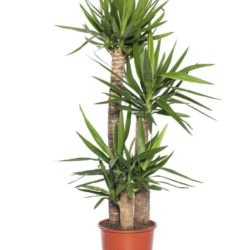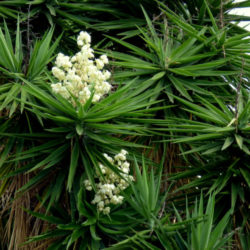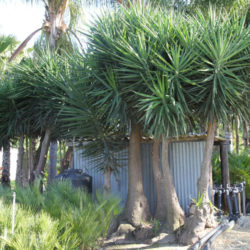Scientific Name
Yucca gigantea Lem.
Common Name(s)
Blue-stem Yucca, Giant Yucca, Soft-tip Yucca, Spineless Yucca
Synonym(s)
Yucca elephantipes var. gigantea
Scientific Classification
Family: Asparagaceae
Subfamily: Agavoideae
Genus: Yucca
Description
Yucca gigantea is a large shrub or small tree with single or several trunks topped with a rosette of spineless, strap-like leaves. It can grow up to 30 feet (10 m) tall. The green leaves measure up to 4 feet (1.2 m) long and 3 inches (7.5 cm) wide.
In summer, mature rosettes produce erect stalks with large clusters of edible, pendent, white flowers. The flower stalks can reach up to 3.3 feet (1 m) in height. The fleshy fruits are oval, brown, and about 1 inch (2.5 cm) long.
Origin
Yucca gigantea is native to Belize, Costa Rica, El Salvador, Guatemala, Honduras, Nicaragua, and the eastern part of Mexico.

Hardiness
USDA hardiness zone 9b to 11b: from 25 °F (−3.9 °C) to 40 °F (+4.4 °C).
How to Grow and Care
Under the right conditions, Yuccas are not difficult plants to grow. They tend to thrive on a bit of neglect rather than too much attention. They are especially easy to overwater, and soggy stems are a sign of too much water. The best conditions for Yucca include a sunny corner with relatively low humidity. They are not prone to many pests, although scale can be an issue. Over time, plants will typically lose their lower leaves (in nature, they droop, forming a skirt around the trunk), giving the plant a pleasant "tree-like" appearance.
Yuccas are relatively slow-growing plants that should only need to be repotted every other year. They do well, slightly pot-bound, as long as they don't become heavy enough to tip over their containers.
See more at How to Grow and Care for Yucca.
Links
- Back to genus Yucca
- Succupedia: Browse succulents by Scientific Name, Common Name, Genus, Family, USDA Hardiness Zone, Origin, or cacti by Genus
Photo Gallery
Click on a photo to see a larger version.



